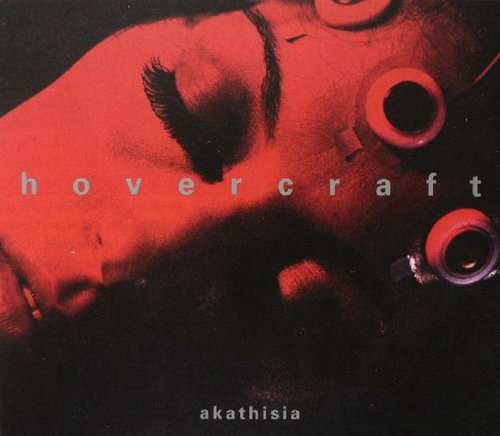I bought Akathisia on a holiday whim a few years ago. There was a really haggard, beat-up copy of the double LP in the “used new arrivals” section of a Vancouver record store — I picked it up, saw that Blast First put it out, and decided to give it a spin. When I went to purchase it the store’s clerk sneered, “uhh, we’ve got other Pearl Jam stuff if you’re looking for it.”
For obvious reasons I was confused and, being a record store clerk of discerning taste myself, offended. The clerk informed me that one Eddie Vedder was in Hovercraft, and all of a sudden I felt a tinge of nausea. I cautiously previewed another side of the record, but was not swayed to the negative — perhaps the tom-heavy drum production was a bit too mid-90s, but otherwise, I was impressed with Hovercraft’s long-form space/noise-rock explorations. I purchased the album, the clerk tried to sell me a copy of The Devils Jukebox boxset that was missing the Sonic Youth and Lee Ranaldo singles, and we both went on our merry ways.
Mr. Vedder does not appear on Akathisia, or on Hovercraft’s equally venerable follow-up, Experiment Below. He does drum on the band’s earliest material, though under a pseudonym. This is all beside the point, however: speaking strictly musically, Hovercraft, a Seattle three-piece that are way more fun to think of as a group of space rock scientists, have nothing to do with grunge or 90s radio rock — at least nothing beyond that they use guitars and drums. It’s unfortunate that Vedder’s early involvement in the band has colored their entire discography — eBay listings always mention his name, even on records he doesn’t appear on. If anything, the Pearl Jam connection likely turns off the audience that would really appreciate Hovercraft.
Akathisia rides a tension between alternately sharp n’ woozy noise-rock guitar squall and the sort of extended, spaced-out post-rock/drone that Kranky put out in the 90s (e.g., Magnog, some Labradford, early Jessamine, etc.), at prime moments merging exploratory, ozone-scorched feedback with dense, bass-driven undercurrents. Ryan Campbell’s guitar work is too sinewy to be entrenched in Kranky ambient/drone territory, but is also too dynamic to be lumped in with 90s alternative/grunge. Basically, Akathisia often drifts in echo, but with a sharp noise rock core to keep things from getting overbearingly “spacey” or aimlessly post-rock. The end result is appealingly off-kilter and difficult to pin down — “Bad Moon Rising-era Sonic Youth on Kranky” comes close, but even that doesn’t fit entirely.
Hovercraft also worked at establishing a shadowy, obscure aesthetic. The members were credited under tongue-in-cheek science names (on Akathisia, Hovercraft was Sadie 7, Campbell 2000, and Karl 3-30), promo photographs were often shot in silhouette, and the LP version of Akathisia contains an elaborate 14-page booklet loaded with photographs of assorted space/science documentation from the 1950s. In lieu of recording information, the liner notes merely state when Akathisia was “preserved and magnetically encoded.” This all sounds really cheesy and pseudo-mythopoeic, and today the band’s aura dissipates with a simple Google search (oh hey, Sadie 7 is Beth Liebling, Eddie Vedder’s ex-wife!), but thinking about this in the context of the mid-90s makes Hovercraft stick out as heavily indebted to their craft; a genuinely mysterious entity making dense and alien noise rock.
